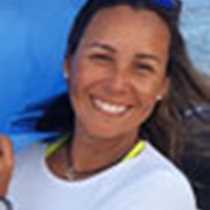North Seymour & Rabida Islands
On our first full day into our expedition, we set off to visit North Seymour. Despite its small size, this island is full of life. The highlight of this place is the number of marine birds that inhabit it, particularly the magnificent and great frigate birds and the blue footed boobies. The local vegetation is rather dry, mostly small bushes and trees towards the interior, but it is here where most of the frigate bird colony is found. These birds have the largest wingspan-to-weight ratio, and with their flight skills are the real masters of the air. Along the path, we encountered several blue-footed boobies, some of which looked after very young chicks. Another emblematic species that occurs here is the land iguana; they make a contrast with their yellow scales against the dull colored ground! The endemic marine iguanas were found along the shoreline; where they are close to the marine algae they exclusively feed on. It is truly remarkable how all these creatures show fearlessness towards us humans as we walk through their colonies or territories, a characteristic that makes the Galapagos Islands unique in the planet.
In the afternoon we navigated westwards to our new destination, Rabida Island. The landscape here is already very different to that of North Seymour. Rabida is small but tall, and its lavas are reddish due to the presence of iron oxide. It was time to enjoy the Galapagos waters, so our guests had plenty of choices today. Some decided to explore the coastline by kayak; our deep water snorkelers jumped in to find the wonders of the local underwater world while others preferred to practice their snorkeling skills from the beach. It was a real treat to share the beach with a colony of Galapagos sea lions! A little later, we disembarked once again on Rabida Island for a short walk. The scenery is dominated by a native incense tree, also called “palo santo”. As we ventured inland we could spot several land bird species, like the Galapagos mockingbird, several Darwin finch species, doves and a flycatcher. At a higher point we made a stop, from which we could see the outlines of distant Isabela and Fernandina; these are the youngest and westernmost islands of this archipelago. The sun was setting and the day was coming to an end, so it was time to return to the ship. Tomorrow when we wake up we will already be in the west, exploring the most remote corners of the Enchanted Islands.




